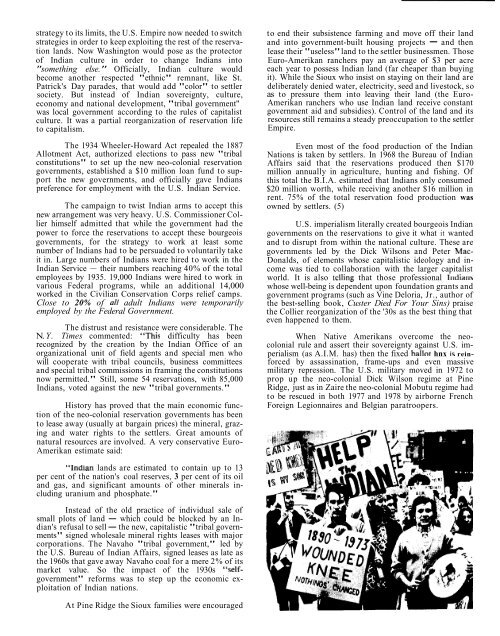sakaisettlersocr
sakaisettlersocr
sakaisettlersocr
Create successful ePaper yourself
Turn your PDF publications into a flip-book with our unique Google optimized e-Paper software.
strategy to its limits, the U.S. Empire now needed to switch<br />
strategies in order to keep exploiting the rest of the reservation<br />
lands. Now Washington would pose as the protector<br />
of Indian culture in order to change Indians into<br />
"something else." Officially, Indian culture would<br />
become another respected "ethnic" remnant, like St.<br />
Patrick's Day parades, that would add "color" to settler<br />
society. But instead of Indian sovereignty, culture,<br />
economy and national development, "tribal government''<br />
was local government according to the rules of capitalist<br />
culture. It was a partial reorganization of reservation life<br />
to capitalism.<br />
The 1934 Wheeler-Howard Act repealed the 1887<br />
Allotment Act, authorized elections to pass new "tribal<br />
constitutions" to set up the new neo-colonial reservation<br />
governments, established a $10 million loan fund to support<br />
the new governments, and officially gave Indians<br />
preference for employment with the U.S. Indian Service.<br />
The campaign to twist Indian arms to accept this<br />
new arrangement was very heavy. U.S. Commissioner Collier<br />
himself admitted that while the government had the<br />
power to force the reservations to accept these bourgeois<br />
governments, for the strategy to work at least some<br />
number of Indians had to be persuaded to voluntarily take<br />
it in. Large numbers of Indians were hired to work in the<br />
Indian Service - their numbers reaching 40% of the total<br />
employees by 1935. 19,000 Indians were hired to work in<br />
various Federal programs, while an additional 14,000<br />
worked in the Civilian Conservation Corps relief camps.<br />
Close to 20% of aN adult Indians were temporarily<br />
employed by the Federal Government.<br />
The distrust and resistance were considerable. The<br />
N. Y. Times commented: "This difficulty has been<br />
recognized by the creation by the Indian Office of an<br />
organizational unit of field agents and special men who<br />
will cooperate with tribal councils, business committees<br />
and special tribal commissions in framing the constitutions<br />
now permitted." Still, some 54 reservations, with 85,000<br />
Indians, voted against the new "tribal governments."<br />
History has proved that the main economic function<br />
of the neo-colonial reservation governments has been<br />
to lease away (usually at bargain prices) the mineral, grazing<br />
and water rights to the settlers. Great amounts of<br />
natural resources are involved. A very conservative Euro-<br />
Amerikan estimate said:<br />
to end their subsistence farming and move off their land<br />
and into government-built housing projects - and then<br />
lease their "useless" land to the settler businessmen. Those<br />
Euro-Amerikan ranchers pay an average of $3 per acre<br />
each year to possess Indian land (far cheaper than buying<br />
it). While the Sioux who insist on staying on their land are<br />
deliberately denied water, electricity, seed and livestock, so<br />
as to pressure them into leaving their land (the Euro-<br />
Amerikan ranchers who use Indian land receive constant<br />
government aid and subsidies). Control of the land and its<br />
resources still remains a steady preoccupation to the settler<br />
Empire.<br />
Even most of the food production of the Indian<br />
Nations is taken by settlers. In 1968 the Bureau of Indian<br />
Affairs said that the reservations produced then $170<br />
million annually in agriculture, hunting and fishing. Of<br />
this total the B.I.A. estimated that Indians only consumed<br />
$20 million worth, while receiving another $16 million in<br />
rent. 75% of the total reservation food production was<br />
owned by settlers. (5)<br />
U.S. imperialism literally created bourgeois Indian<br />
governments on the reservations to give it what it wanted<br />
and to disrupt from within the national culture. These are<br />
governments led by the Dick Wilsons and Peter Mac-<br />
Donalds, of elements whose capitalistic ideology and income<br />
was tied to collaboration with the larger capitalist<br />
world. It is also tclling that those professional 11idia11><br />
whose well-being is dependent upon foundation grants and<br />
government programs (such as Vine Deloria, Jr., author of<br />
the best-selling book, Custer Died For Your Sins) praise<br />
the Collier reorganization of the '30s as the best thing that<br />
even happened to them.<br />
When Native Amerikans overcome the neocolonial<br />
rule and assert their sovereignty against U.S. imperialism<br />
(as A.I.M. has) then the fixed ballot hnx is reinforced<br />
by assassination, frame-ups and even massive<br />
military repression. The U.S. military moved in 1972 to<br />
prop up the neo-colonial Dick Wilson regime at Pine<br />
Ridge, just as in Zaire the neo-colonial Mobutu regime had<br />
to be rescued in both 1977 and 1978 by airborne French<br />
Foreign Legionnaires and Belgian paratroopers.<br />
"Indian lands are estimated to contain up to 13<br />
per cent of the nation's coal reserves, 3 per cent of its oil<br />
and gas, and significant amounts of other minerals including<br />
uranium and phosphate."<br />
Instead of the old practice of individual sale of<br />
small plots of land - which could be blocked by an Indian's<br />
refusal to sell - the new, capitalistic "tribal governments"<br />
signed wholesale mineral rights leases with major<br />
corporations. The Navaho "tribal government," led by<br />
the U.S. Bureau of Indian Affairs, signed leases as late as<br />
the 1960s that gave away Navaho coal for a mere 2% of its<br />
market value. So the impact of the 1930s "selfgovernment"<br />
reforms was to step up the economic exploitation<br />
of Indian nations.<br />
At Pine Ridge the Sioux families were encouraged


